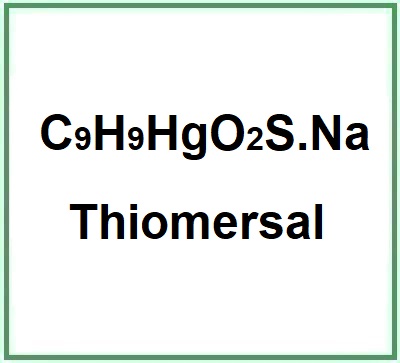![]() Thiomersal
Thiomersal
Rating : 5
| Evaluation | N. Experts | Evaluation | N. Experts |
|---|---|---|---|
| 1 | 6 | ||
| 2 | 7 | ||
| 3 | 8 | ||
| 4 | 9 | ||
| 5 | 10 |
Cons:
Possible eye irritant (1)10 pts from Street82
| Sign up to vote this object, vote his reviews and to contribute to Tiiips.Evaluate | Where is this found? |
| "Thiomersal studies" about Thiomersal Review Consensus 10 by Street82 (2970 pt) | 2022-Jul-24 19:50 |
| Read the full Tiiip | (Send your comment) |
Compendium of the most significant studies with reference to properties, intake, effects.
Gołoś A, Lutyńska A. Thiomersal-containing vaccines - a review of the current state of knowledge. Przegl Epidemiol. 2015;69(1):59-64, 157-61.
Abstract. Thiomersal is an organomercury compound known for its antiseptic and antifungal properties and used as an antibacterial agent in pharmaceutical products, including vaccines and other injectable biological products. In recent years, concerns about the possible link between immunization with thiomersal-containing vaccines and autism development have grown. Many case-control and cohort studies have been conducted on a number of populations, and none of them have confirmed the hypothetical relation between thiomersal and increased risk of autism spectrum disorders (ASDs) development. It is also confirmed by the fact, that since 1999, number of thiomersal-containing vaccines used worldwide is decreasing year by year, while the prevalence of ASDs cases is rising. There are no contraindications to the use of vaccines with thiomersal in infants, children and non-pregnant women. The risk of serious complications associated with the development of diseases in unvaccinated individuals far outweighs the potential risk of adverse consequences associated with immunization with thiomersal-containing vaccines.
Cox NH, Forsyth A. Thiomersal allergy and vaccination reactions. Contact Dermatitis. 1988 Apr;18(4):229-33. doi: 10.1111/j.1600-0536.1988.tb02809.x.
Abstract. Thiomersal is the preservative in all toxoid vaccines routinely administered to children in the UK, but exposure from other sources is uncommon. Delayed hypersensitivity to thiomersal was demonstrated in 1% of individuals attending the Contact Dermatitis Investigation Unit, and 50 of these patients with positive patch tests to thiomersal were studied. Cross-reaction with other mercurials occurred in 17 of 29 patients tested (59%). 31 of the patients replied to a questionnaire regarding vaccination reactions, and were compared with case-controls matched for age, sex, and site of dermatitis. 4 patients in each group reported reactions to vaccines which contained thiomersal, suggesting that thiomersal hypersensitivity was not associated with an increased risk of vaccination reactions. However, individual cases of severe reactions to thiomersal demonstrate a need for vaccines with an alternative preservative.
Kaur K, Xiong J, Sawant N, Agarwal S, Hickey JM, Holland DA, Mukhopadhyay TK, Brady JR, Dalvie NC, Tracey MK, Love KR, Love JC, Weis DD, Joshi SB, Volkin DB. Mechanism of Thimerosal-Induced Structural Destabilization of a Recombinant Rotavirus P[4] Protein Antigen Formulated as a Multi-Dose Vaccine. J Pharm Sci. 2021 Mar;110(3):1054-1066. doi: 10.1016/j.xphs.2020.11.033.
Abstract. In this work, the mechanism(s) of thimerosal-P[4] protein interactions, along with subsequent effects on the P[4] protein's structural integrity, are determined.
de Magalhães Silva M, de Araújo Dantas MD, da Silva Filho RC, Dos Santos Sales MV, de Almeida Xavier J, Leite ACR, Goulart MOF, Grillo LAM, de Barros WA, de Fátima Â, Figueiredo IM, Santos JCC. Toxicity of thimerosal in biological systems: Conformational changes in human hemoglobin, decrease of oxygen binding capacity, increase of protein glycation and amyloid's formation. Int J Biol Macromol. 2020 Jul 1;154:661-671. doi: 10.1016/j.ijbiomac.2020.03.156.
Abstract. Thimerosal (TH), an organomercurial compound, is used as a preservative in vaccines and cosmetics. Its interaction with human hemoglobin (Hb) was investigated under physiological conditions using biophysical and biological assays, aiming to evaluate hazardous effects.
Huang X, Li Y, Nie M, Yue M, Li Y, Lin Z, Pan H, Fang M, Wu T, Li S, Zhang J, Xia N, Zhao Q. Capsid destabilization and epitope alterations of human papillomavirus 18 in the presence of thimerosal. J Pharm Anal. 2021 Oct;11(5):617-627. doi: 10.1016/j.jpha.2020.08.007.
Abstract. This study aims to investigate the effects of thimerosal on the capsid stability and antigenicity of recombinant human papillomavirus (HPV) 18 virus-like particles (VLPs). Dramatic destabilization of the recombinant viral capsid upon thimerosal treatment was observed.
Mamber SW, Hatch T, Miller CS, Murray JV, Strout C, McMichael J. Low-dose Oral Thimerosal for the Treatment of Oral Herpes: Clinical Trial Results and Improved Outcome After Post-hoc Analysis. J Evid Based Integr Med. 2022 Jan-Dec;27:2515690X221078004. doi: 10.1177/2515690X221078004.
Abstract. Thimerosal (TML) is an organomercury antimicrobial. Low doses (1/250th of the amount in a typical vaccine dose) may promote an antiviral immune response. Low-dose TML (BTL-TML) was evaluated for safety and efficacy against herpes labialis in two FDA-approved, randomized, double blind, placebo-controlled clinical trials.
| Sign up to vote this object, vote his reviews and to contribute to Tiiips.EvaluateClose | (0 comments) |
| "Descrizione" about Thiomersal Review Consensus 10 by Street82 (2970 pt) | 2023-May-03 11:28 |
| Read the full Tiiip | (Send your comment) |
Tiomersal or Thimerosal is an organomercury compound that comprises 49.55% (w/w) mercury in its structure and degrades to produce thiosalicylic acid, dithiobenzoic acid and ethylmercury (1).
It appears in the form of a beige powder incompatible with iodine, heavy metal salts, strong acids, strong bases, strong oxidizing agents.

What it is used for and where
Medical
Due to its bacteriostatic and fungistatic properties, Tiomersal is used as a preservative in vaccines against hepatitis B, influenza, diphtheria, tetanus, pertussis, meningococcal disease and Haemophilus influenzae type B. The typical concentration of Tiomersal in vaccines is 0.01%.
Safety
The WHO considers small doses of Tiomersal to be safe even with multiple and repetitive exposures to vaccines administered during childhood or to pregnant women.
On its safety, some studies consider that current knowledge on this subject (2013) is still incomplete and further studies are needed (2), while the most recent scientific literature (2022) have highlighted the toxicity of mercury that would lead to structural and functional changes in macromolecules such as haemoglobin in erythrocytes (3).
In this 2004 study, Tiomersal or Thimerosal is indicated as a true ophthalmic allergen in periorbital allergic contact dermatitis (4).
It may be useful to perform a preventive patch-test before taking this chemical to check that no allergic problems arise.
Cosmetics
It is a restricted ingredient V/16 a Relevant Item in the Annexes of the European Cosmetics Regulation 1223/2009. Maximum concentration in ready for use preparation 0.007% (Hg).If mixed with other mercurial compounds authorized by this Regulation, the maximum concentration of Mercury remains fixed at 0.007%
Other uses
Paints, industrial catalyst.
The most relevant studies on this chemical compound have been selected with a summary of their contents:
Typical commercial product characteristics Thiomersal
| Appearance | Beige powder |
| pH | 6.0 - 8.0 |
| Boiling Point | 298.6ºC at 760mmHg |
| Melting Point | 234-237 °C |
| Flash Point | 250 °C |
| PSA | 65.43000 |
| LogP | 1.57790 |
| Free mercury ions | ≤ 0.70 % |
| Loss on drying | ≤ 0.5 % |
| Diethyl ether | ≤ 5000 ppm |
| Ethanol | ≤ 5000 ppm |
| Safety | 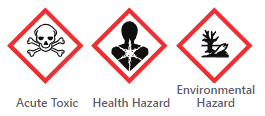 |
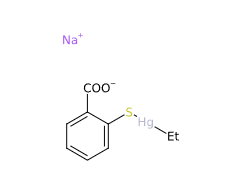 | 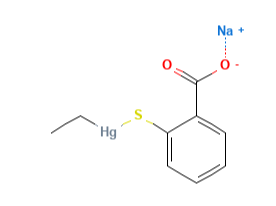 |
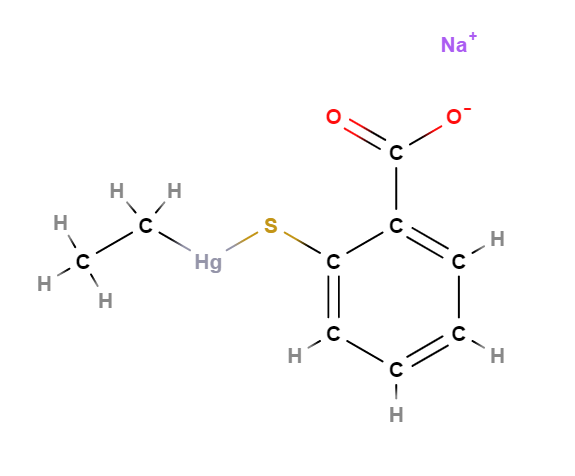 |
- Molecular Formula C9H9HgO2S.Na C9H9HgNaO2S
- Linear Formula 2-(C2H5HgS)C6H4CO2Na
- Molecular Weight 404.82
- Exact Mass 405.992706
- CAS 54-64-8
- UNII 2225PI3MOV
- EC Number 200-210-4
- DSSTox Substance ID DTXSID3025540
- IUPAC sodium;(2-carboxylatophenyl)sulfanyl-ethylmercury
- InChI=1S/C7H6O2S.C2H5.Hg.Na/c8-7(9)5-3-1-2-4-6(5)10;1-2;;/h1-4,10H,(H,8,9);1H2,2H3;;/q;;2*+1/p-2
- InChl Key RTKIYNMVFMVABJ-UHFFFAOYSA-L
- SMILES CC[Hg]SC1=CC=CC=C1C(=O)[O-].[Na+]
- MDL number MFCD00013062
- PubChem Substance ID 24900219
- ChEBI 9546
- NCI C47751
- RXCUI 10472
- Beilstein 8169555
- RTECS OV8400000
- UN 2025
Synonyms
- 2-(Ethylmercuriomercapto)benzoic acid sodium salt
- Mercury-([o-carboxyphenyl]thio)ethyl sodium salt
- Thimerosal
- Thiomersal
References______________________________________________________________________
(1) Pedrozo-Penafiel MJ, Miranda-Andrades JR, Gutierrez-Beleño LM, Larrudé DG, Aucelio RQ. Indirect voltammetric determination of thiomersal in influenza vaccine using photo-degradation and graphene quantum dots modified glassy carbon electrode. Talanta. 2020 Aug 1;215:120938. doi: 10.1016/j.talanta.2020.120938.
(2) Dórea JG, Farina M, Rocha JB. Toxicity of ethylmercury (and Thimerosal): a comparison with methylmercury. J Appl Toxicol. 2013 Aug;33(8):700-11. doi: 10.1002/jat.2855.
(3) Sales MVS, da Silva Filho RC, Silva MM, Rocha JL, Freire RO, de L Tanabe EL, Silva ECO, Fonseca EJS, Figueiredo IM, Rocha U, Santos JCC, Leite ACR. Consequences of thimerosal on human erythrocyte hemoglobin: Assessing functional and structural protein changes induced by an organic mercury compound. J Trace Elem Med Biol. 2022 Jan 10;71:126928. doi: 10.1016/j.jtemb.2022.126928.
(4) Herbst RA, Uter W, Pirker C, Geier J, Frosch PJ. Allergic and non-allergic periorbital dermatitis: patch test results of the Information Network of the Departments of Dermatology during a 5-year period. Contact Dermatitis. 2004 Jul;51(1):13-9. doi: 10.1111/j.0105-1873.2004.00334.x.
Abstract. Periorbital dermatitis is common and can be due to the external use of ophthalmic drugs. We evaluated patch test results of the Information Network of the Departments of Dermatology. During a 5-year period (1995-99), of a total 49,256 patch-tested patients, 1053 (2.1%) were eventually diagnosed as allergic periorbital contact dermatitis (APD) and 588 (1.2%) as non-allergic periorbital dermatitis (NAPD). Patient characteristics between APD, NAPD and other cases (OCs) differed with respect to sex (19.7% male in both periorbital groups versus 36.3% in OCs), atopic dermatitis (10.4% in APD versus 60.2% in NAPD versus 16.9% in OCs) and age, APD being substantially more often (68.2%) aged 40 and above than NAPD (52.6%). Several of the top allergens in OCs [such as fragrance mix, Myroxylon pereirae resin (balsam of Peru), lanolin alcohol and potassium dichromate] caused significantly fewer positive test reactions in both periorbital groups. In contrast, thimerosal, phenylmercuric acetate, sodium disulfite, gentamicin sulfate, phenylephrine hydrochloride and benzalkonium chloride tested positively significantly more often in APD but not in NAPD, verifying them as true ophthalmic allergens. Finally, in 42 cases (4%) of APD patients, additional allergens were identified by testing of the patients' own substances (mostly beta-blockers, oxybuprocaine and dexpanthenol), supporting the necessity of testing with ophthalmic drugs as is where individual substances are not readily available.
| Sign up to vote this object, vote his reviews and to contribute to Tiiips.EvaluateClose | (0 comments) |
Read other Tiiips about this object in __Italiano (2)
Component type: Chemical Main substances:
Last update: 2023-02-27 15:59:57 | Chemical Risk: |


